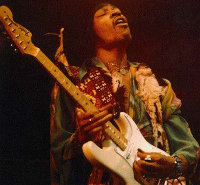There are several ways to increase sustain and/or obtain controlled
feedback. However, it must be stressed that feedback occurs in a system at a
point of high gain and resonance, which does not always coincide with where
you want it.

For example, high pitch whistles often occur when a guitar pickup is
situated near speakers/horn drivers due to magnetic coupling, ie. between
the coil in the pickup and the one in the speaker. The guitar pickup is
usually electrically resonant at a high audio pitch so of course that is
where it ‘screeches. Acoustic feedback also occurs easily on hollow bodied
instruments where the body is tuned. Acoustic guitars for example feedaback
at bass frequencies. That is why many ‘acoustic’ amplifiers incorporate
‘anti-feedback’ devices like tuned notch filters.
Anyway, here are a few ways to increase sustain/feedback starting with the
most subtle. Use in combination and in moderation.
1. Use heavier gauge strings. They vibrate for longer so require less
feedback to hold a note.
2. Make the guitar as rigid as possible. This particularly applies if you
have a bolt on neck. Make sure the screws are tight or this will cause
reduced sustain of the string.
3. Use hard materials for the Bridge and Nut parts that are in contact with
the string. For my own strat, I made a new Nut out of an old brass tap. This
replaced the plastic one supplied with the guitar I bought in 1972.
4. Lower the pickups to increase the distance between the pole pieces and
strings. Some people raise the pickups to produce maximum drive to the
amplifier. Unfortunately, pole pieces are magnetic, and close proximity to
strings will dampen their vibration.
5. Use a high output pickup. Seymour Duncan have a strat single coil
replacement that is very resonant. Easy to get feedback just above middle
pitches but at the expense of losing the high ‘top’ you expect from strat’s.
6. An old method is to use a treble boost before the amplifier (or effects
unit) to overdrive it.
When an amplifier overloads it clips the signal, high overload simply causes
the output waveform to eventually switch between two voltage levels of a
value determined by the internal power supplies. This is known as going ‘dc’
and can easily damage Hi-Fi’s. However, good guitar amplifiers are designed
to work with this.
The audible effect is an increase in bass, going woolly and harmonic
distortion. The addition of the treble boost counteracts the Bass and
improves ‘clarity’ and rich harmonics. This in turn increases the likehood
of feedback where you want it (if not overdone).
All the above can maintain the character of your guitar when used in
moderation. However, if the priority is just a long note then obtrusive
effects and other ways can be used. Sometimes the amplifier itself just
needs more ‘ooomph’ to get attitude and sustain out of it. Ways forward are:
1. Add a couple of cheap piezo tweeters. Put these in a small box on top of
the amplifier and parallel with the main speaker. This will cause a MAJOR
difference in sound. Use two Maplin RT60Q or CJ83E wired in series, these
are under fifteen pounds the pair and can really add life to an old
amplifier.
2. An effect like the Line 6 POD can provide really good overdrive and
simulates the sounds of different amplifiers. At low volume you can have
long sharp sustain like Gary Moore, or select Marshall overdrive for the
Status Quo sound. Unfortunately, it has several shortcomings. i) You get
someone else’s sound. (But you may not care) ii) There is no bypass switch.
iii) It generally has a poor ‘low drive’ sound. iv) It has no high ‘top’. A
side effect of the way the internal technology is used. Sampled sounds in
some keyboards also have this problem.
3. Try using an ‘aural exciter’ in conjunction with (or in place of) the
amplifier treble control. You get a lot more harmonics that help induce
feedback at ‘higher’ places on the guitar neck.
4. The ultimate is to use a guitar to midi convertor with synth module. Just
press the hold button after hitting a note and it will continue until the
neighbours start bashing at the front door. (Been there, done it, etc..)
Reposted from Guitar News Weekly Edition #162, October 1, 2001
Related Gear:

Just what I was looking for! Thanks man! Tip No1 is gold!
I have an old digitech RP7 that I purchased used off eBay probably 8-10 years ago. It has one 12AX7 tube in it. I upgraded the tube to a NOS RCA, and I get really great sustain using that thing with my tube amps.
My primary amp is an old Fender PA 100, circa 1968 I think, that I’ve had for more than thirty years; followed by a ’90’s crate 5212VC head; and then a newer Bugera V22 1×12.
The RP7 works really well with all three of these amps, and gives each a much nicer tone. The really great thing about the RP7 is that is does have a bypass switch which allows you to pass through it directly to the amp, when desired.